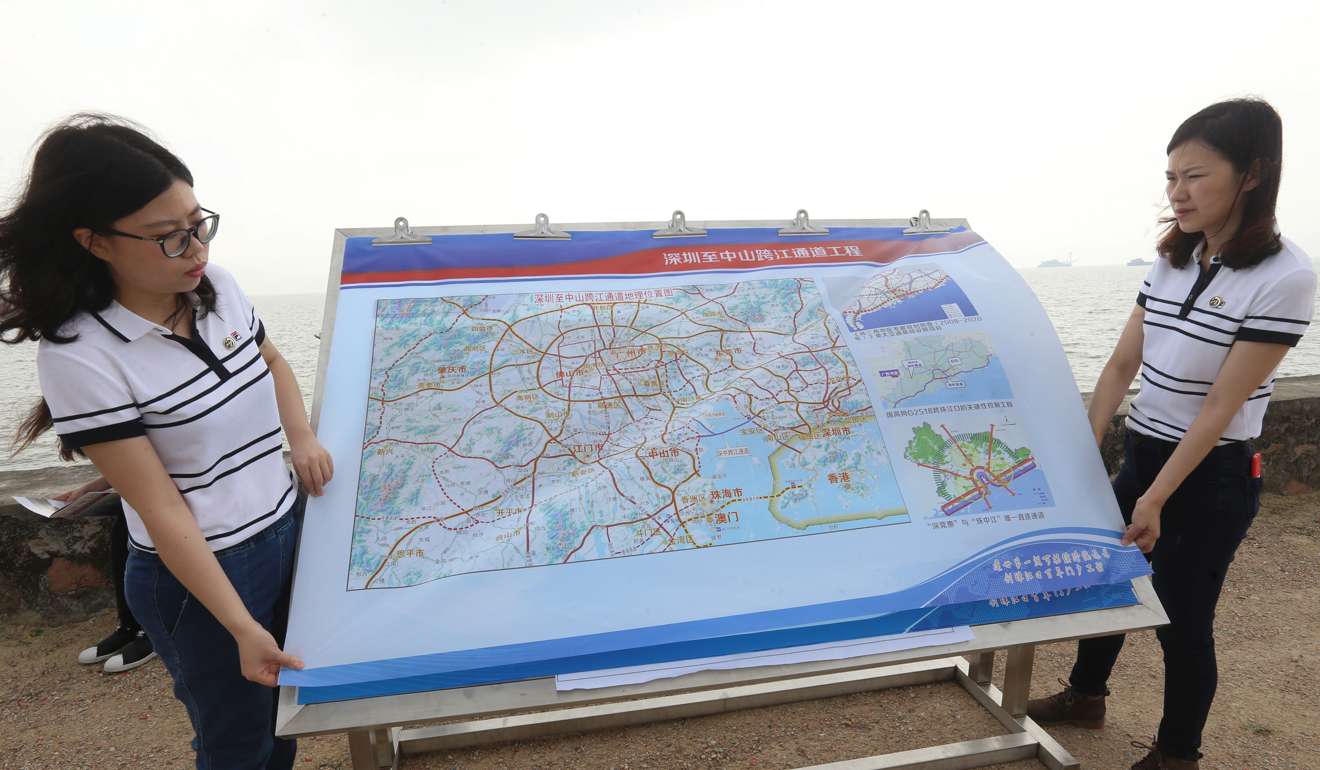Hong Kong leader plays down fears of rising inter-city rivalry
On a visit to the site of a mega-bridge project, the chief executive says the city and all its neighbours will benefit from Beijing’s integration plan

Hong Kong leader Leung Chun-ying on Friday sought to downplay the growing rivalry between the city and its mainland neighbours, insisting they would all benefit under Beijing’s “Greater Bay Area” integration plan.
The chief executive said he did not see competition as a problem as he visited the site of a bridge being built between Shenzhen and Zhongshan, a project that could directly rival a troubled bridge connecting to Hong Kong.
Hong Kong could have “bigger potential and better ties” with its neighbours than other cities around the world, he added, explaining the need to facilitate the flow of people, goods and capital.
Wrapping up a three-day study tour in Guangdong province, Leung said his delegation, including Hong Kong’s top ministers and about 20 advisers, would meet again in two to three weeks’ time. They have been tasked to come up with preliminary ideas about the city’s role in the plan to link up Hong Kong, Macau and nine cities in Guangdong. The government will submit a formal proposal to Beijing by June.
The chief executive was speaking hours after his delegation visited the Hong Kong-Zhuhai-Macau bridge in Zhuhai, and the landing point of the planned Shenzhen-Zhongshan bridge. The two mega-bridges are scheduled for completion this year and in 2024 respectively, and are expected to be competitors as the newer bridge will offer a potentially more convenient option for drivers in Zhongshan to travel to Shenzhen and beyond.
A member of the delegation, who spoke on condition of anonymity, said Hong Kong would meet the challenge by charging less for the use of its bridge, as well as by forging closer ties with Zhuhai and neighbouring cities such as Zhongshan and Jiangmen.
“Previously, officials were thinking about the financial return of the bridge, but now it seems its social and economic returns are more important,” he said.

Leung played down the possibility of an escalation of inter-city rivalry. “Hong Kong is far away from Zhuhai and Macau, and it’s inconvenient to rely on boats only,” he said.
“With a bridge, Hong Kong’s ties with the two cities, as well as Zhongshan and Foshan, will be closer, and it will be more convenient for Hong Kong people to travel to the western coast of the Pearl River [Delta].”
The chief executive said his administration was discussing policy with Beijing related to the movement of mainland vehicles into Hong Kong and vice versa. The central government would ensure Hong Kong would not be inundated with mainland vehicles, he added.
The “Greater Bay Area” integration plan covers a total area of 56,000 sq km and a population of more than 66 million. It was first proposed by Guangdong officials several years ago, but grew into a national strategic project after Premier Li Keqiang endorsed it in his annual work report last month.
Asked if his administration would do anything to minimise rivalry in the region, Leung said: “There is competition between Hong Kong and any city in the world, and we have benefited and progressed in the midst of such competition.
“Nevertheless, our cooperation and potential with the nine mainland cities are bigger and better [than our competition], because Hong Kong is most internationalised here ... and the Greater Bay Area needs to rely on this.”
Leung reiterated that two key questions to be discussed were how to promote the flow of people, goods and capital in the region, as well as how the integration scheme could fit into Beijing’s “Belt and Road” global trade strategy to revive commerce along the old Silk Route.
The anonymous source added that during the trip, officials from cities such as Zhaoqing, Jiangmen and Foshan expressed strong interest in cooperating with Hong Kong, especially with its financial and entertainment sectors.
“The message from some mainland officials is that rather than working with Shenzhen on these industries, Hong Kong should work with us because we have more land and growth potential,” the source said.
Meeting the delegation on Friday, Zhuhai’s acting mayor, Li Zezhong, said his city would seek to make it easier for people and goods to get through checkpoints of the Hong Kong-Zhuhai-Macau bridge.